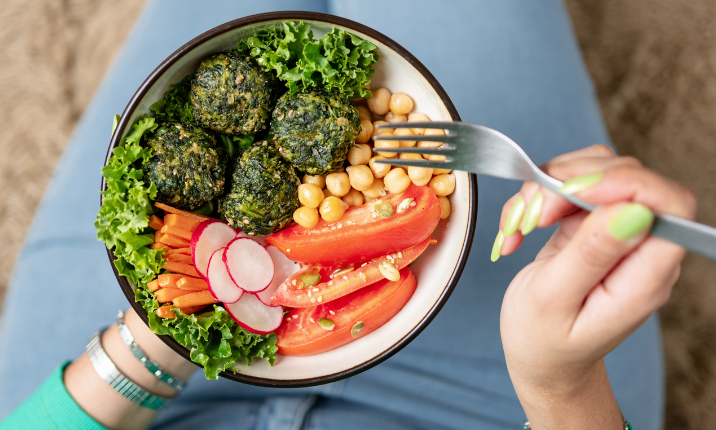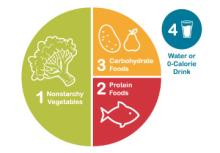For people with diabetes, fresh herbs can be a game changer. They boost the deliciousness of a recipe without needing to add excess salt or butter. Research finds herbs, in general, provide naturally occurring polyphenols with strong antioxidant properties, offering potential benefits for people with or trying to prevent type 2 diabetes.
How to Store Fresh Herbs
Herbs should smell fresh and have no yellowing or sliminess. Consider storing fresh herbs by rinsing with water, patting the leaves dry, snipping 1/2-inch off stems, and keeping them in the fridge like a flower bouquet, gently covering with a produce bag. If it’s basil, keep at room temperature. Storage time varies per herb but expect them to remain fresh for about one week.
Tips for Cooking with Fresh Herbs
Typically, use triple the amount of fresh herbs as dried in recipes. For example, if a recipe calls for one teaspoon of dried thyme, use three teaspoons of fresh thyme. Add tender stemmed herbs, like basil, cilantro, and mint at the end of the cooking process or upon serving to keep their lively color and aromatic goodness.
Sturdier-stemmed herbs, like oregano, thyme, and rosemary, can be used early in the cooking process. For a fresh recipe (no heat required), add fresh herbs anytime, going as heavy as your taste buds enjoy.
6 Fresh Summer Herbs
1. Basil

Pairs well with vegetables (including cauliflower, corn, cucumbers, eggplant, peas, potatoes, spinach, tomatoes, and zucchini), fruits, grains, pasta, pulses (beans), eggs, cheese dishes, chicken, and tuna.
Try this:
- If tossing pasta with store-bought sauce, generously top with sliced basil for a fresh flavor.
- Create a memorable yet simple salad with corn, tomatoes, basil, and cider vinaigrette.
- Complete tomato or white bean soup with an aromatic sprinkling of fresh basil
2. Cilantro

Pairs well with vegetables (including bell peppers, carrots, corn, cucumbers, sweet potatoes, and tomatoes), fruits (including avocado), grains, pulses (beans), and chicken.
Try this:
- Stir cilantro, lime juice, and an optional pinch of chili powder or cumin into Dijon mustard for a versatile Mexican-inspired condiment.
- Create a basting sauce for roasting or grilling based on cilantro, lime juice and zest, honey, garlic, salt, and pepper.
- Upgrade grains with a generous finish of lime juice and fresh cilantro.
3. Mint

Pairs well with vegetables (including bell peppers, carrots, corn, cucumbers, eggplant, green beans, peas, potatoes, and tomatoes), fruits, grains, yogurt, red meat, and chocolate.
Try this:
- Boost salad liveliness by tossing in whole small fresh mint leaves as one of the greens.
- Make mint your fragrant herb of choice in bulgur or another grain salad.
- Infuse water with crushed fresh mint leaves and fresh fruit to stay hydrated in the heat.
4. Oregano

Pairs well with vegetables (including artichokes, bell peppers, corn, eggplant, mushrooms, onions, summer squash, and tomatoes), pasta, pulses (beans), eggs, fish (including anchovies), chicken, and red meat.
Try this:
- Give all-American sandwiches Italian flair by sneaking in a mixture of chopped pepperoncini and oregano.
- Include fresh oregano in homemade herbed oil and lightly drizzle onto non-starchy veggies.
- Choose minced fresh oregano as the starring herb in a kebab marinade.
5. Rosemary

Pairs well with vegetables (including bell peppers, cabbage, peas, potatoes, and tomatoes), apricots, oranges, pulses (beans), soups/stews, eggs, fish, chicken, and ham.
Try this:
- Use rosemary stems as skewers for grilling—they can impart extra flavor.
- Add a Tuscan twist to bean soup and beyond with the dynamic duo of basil and rosemary.
- Marry orange with rosemary to create a lively glaze for salmon or poultry.
6. Thyme

Pairs well with vegetables (including bell peppers, cabbage, carrots, cauliflower, corn, mushrooms, onions, parsnips, and potatoes), blueberries, lemons, pulses (beans), soups/stews, ricotta, eggs, fish, chicken, duck, rabbit, and red meat.
Try this:
- Making something sweet or savory with blueberries? Add a pinch of fresh thyme for intrigue.
- Add fresh thyme as the not-so-secret ingredient to sautéed mushrooms.
- Go fancy by serving a cauliflower “steak” meal with a grape, mustard, and thyme sauce.
Sign up for the Diabetes Food Hub e-newsletter for more recipes ideas on how to include fresh herbs in your diabetes-friendly eating plan.




















































